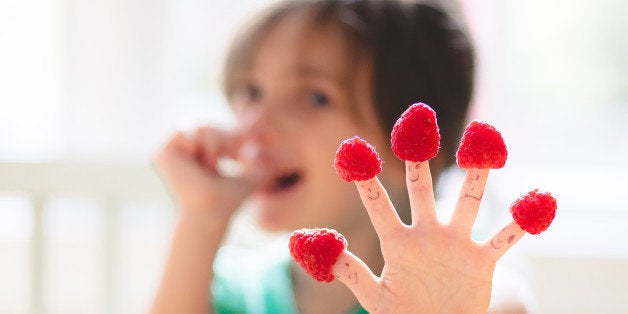
Is your child a picky eater or even a junk food junkie? As a dietitian, I hear that from a lot of concerned parents. Developing healthy eating habits is hard, but not impossible, and it's never too late. What a great thing to focus on in tackling obesity and other diseases -- prevention by teaching our kids the importance and impact of healthy eating. Kids of all ages can learn healthy eating habits and it is never too late to get started. Check out my top five ways to get your kids eating healthier. You may find the information relevant for you as well.
1. Easy access.
In order to get your kids to eat healthy, those foods need to be available. Sounds simple, I know, but it does take thought and intention to have a variety of healthy options accessible most of the time. Kids and adults alike will take the easy way, so if there is a whole pineapple in the fridge or chips available, the chips will go first. Now, if the pineapple was cut up and the first thing you see when you open the fridge, it will be more likely to get eaten. If your kids like raw carrots, red pepper or cucumbers, they will be more likely to eat them if they are washed, sliced and ready to go. This doesn't mean that you have to do the prep -- they can get involved in that too, but it is the pre-planning and preparation that is the key. Making healthy snacks easy can be done with the exact reverse -- making unhealthy snacks less abundant and a bit harder to get to. Opening the cupboard to an array of salty snack crackers will mean kids grab these first -- cheesy crackers or chips are easy and hard to beat. However, if they also see healthy granola bars, fruit cups, nut mixtures and whole grain crackers, they may choose a healthier option.
2. In sight, in mind.
Part of making nutritious food easily accessible is putting it in direct eye-sight. There are many fruits that can be kept on the counter in a fruit bowl. Things like tangerines, apples, oranges, bananas and pears can be placed in a bowl or basket in the middle of the kitchen table to remind everyone in the family to eat them. Cut up veggie sticks and other veggies will only go bad down in the bottom drawer. Keep the healthy items -- in the cupboard, refrigerator and freezer -- at eye level.
3. Get the kids involved.
Kids who are involved in menu planning, grocery shopping and food preparation are more likely to eat healthy foods because they feel empowered to be part of the decision making process. This is such a positive learning experience for them and it can be fun! Kids' involvement will look different at different ages but any age works for this. A 4-year-old could pick their favorite red fruit at the store, a 7-year-old can help with entrée and side choices and as kids get older they can help with grocery shopping, meal preparation and cooking. Tweens or teens could even make the supper meal one night each week. The more involved they get, the more eager they will be to try new things.
4. Define your "occasional."
Most of us would agree that healthy eating is about well-balanced meals and snacks, portion control and eating a variety of foods from all food groups. Most would also agree that an occasional treat can fit into a healthy eating plan. However, from my experience as a parent, the frequency of occasional (from both child and adult perspective) and the actual frequency of eating "treats" deserves a second look. I am not about to tell people that a treat or even two each and every day is not allowed, but I will encourage everyone to actually think about how often they eat something classified as unhealthy. Because of all our mindless eating, my guess is that treats happen more than occasionally. If that is the case for you and your family, explore the possibility that maybe unhealthy foods are too easy, too often. In this case, gradually cut back on unhealthy choices and add healthier alternatives until the majority of the foods you and your kids are eating are nutritious.
5. Be a healthy role model.
Kids are going to have a hard time buying into healthy eating if you're not practicing healthy eating yourself. I put this last, but it is for sure not least. In fact, it is probably the most important. Ask yourself if you are eating at least 5 fruits and veggies combined each day. Are you eating a wide variety of healthy foods, open to trying new things and able to control your portions? Your kids aren't going to like exactly what you like and vice versa, but they will notice your eating habits and follow along -- even if they don't want to admit it.